World's Largest Concentration of Royal Tombs
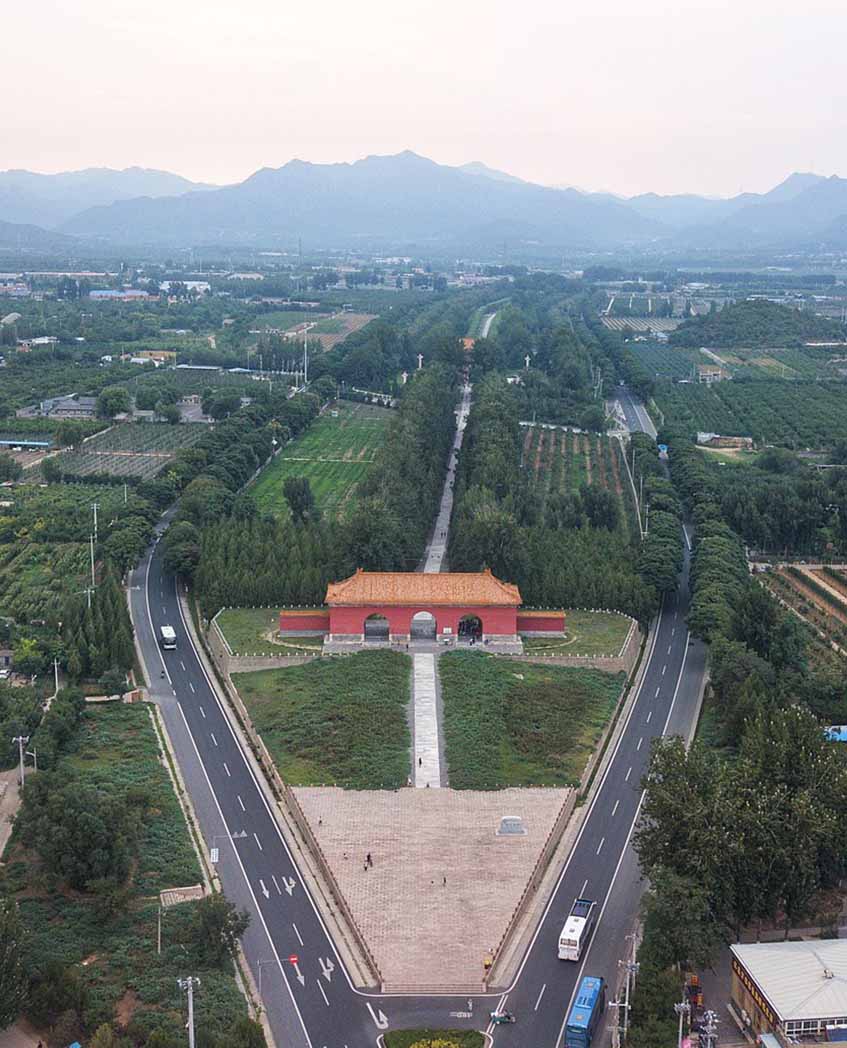
During the early half of the Song Dynasty (960-1279), the study of archaeology developed out of the antiquarian interests of the educated gentry and their desire to revive the use of ancient vessels in state rituals and ceremonies. This and the belief that ancient vessels were products of 'sages' and not common people was criticized by Shen Kuo, who took an interdisciplinary approach to archaeology, incorporating his archaeological findings into studies on metallurgy, optics, astronomy, geometry, and ancient music measures. His contemporary Ouyang Xiu (1007-1072) compiled an analytical catalogue of ancient rubbings on stone and bronze, which Patricia B. Ebrey says pioneered ideas in early epigraphy and archaeology.
In accordance with the beliefs of the later Leopold von Ranke (1795-1886), some Song gentry - such as Zhao Mingcheng (1081-1129) - supported the primacy of contemporaneous archaeological finds of ancient inscriptions over historical works written after the fact, which they contested to be unreliable in regards to the former evidence.
Hong Mai (1123-1202) used ancient Han Dynasty era vessels to debunk what he found to be fallacious descriptions of Han vessels in the Bogutu archaeological catalogue compiled during the latter half of Huizong's reign (1100-1125).

At a distance of 50 km northwest of Beijing stands an arc-shaped cluster of hills fronted by a small plain. Here is where 13 emperors of the Ming dynasty (1368-1644) were buried, and the area is known as the Ming Tombs.
Construction of the tombs started in 1409 and ended with the fall of the Ming Dynasty in 1644. In over 200 years tombs were built over an area of 40 square kilometres, which is surrounded by walls totaling 40 kilometres. Each tomb is located at the foot of a separate hill and is linked with the other tombs by a road called the Sacred Way. The stone archway at the southern end of the Sacred Way, built in 1540, is 14 metres high and 19 metres wide, and is decorated with designs of clouds, waves and divine animals.
Beijing served as the national capital during the Yuan, Ming and Qing dynasties. Unlike Ming and Qing rulers who all built massive tombs for themselves, Yuan rulers left no similar burial grounds.
Beijing nomads came from the Mongolian steppe. Mongols who established the Yuan Dynasty held the belief that they had come from Earth. They adopted a simple funeral method: the dead was placed inside a hollowed nanmu tree, which was then buried under grassland. Growth of grass soon left no traces of the tombs.
During the Ming Dynasty established by Han Chinese coming from an agricultural society in central China, people believed the existence of an after-world, where the dead "lived" a life similar to that of the living. Ming emperors, therefore, has grand mausoleums built for themselves. Qing rulers did likewise.
The stone archway at the southern end of the Sacred Way, built in 1540, is 14 metres high and 19 metres wide, and is decorated with designs of clouds, waves and divine animals. Well-proportioned and finely carved, the archway is one of the best preserved specimens of its kind in the Ming Dynasty. It is also the largest ancient stone archway in China.
The Stele Pavilion, not far from the Great Palace Gate, is actually a pavilion with a double-eaved roof. On the back of the stele is carved poetry written by Emperor Qianlong of the Qing Dynasty when he visited the Ming Tombs.
The Sacred Way inside the gate of the Ming Tomb is lined with 18 pairs of stone human figures and animals. These include four each of three types of officials: civil, military and meritorious officials, symbolizing those who assist the emperor in the administration of the state, plus four each of six types of animals: lion, griffin, camel, elephant, unicorn and horse.
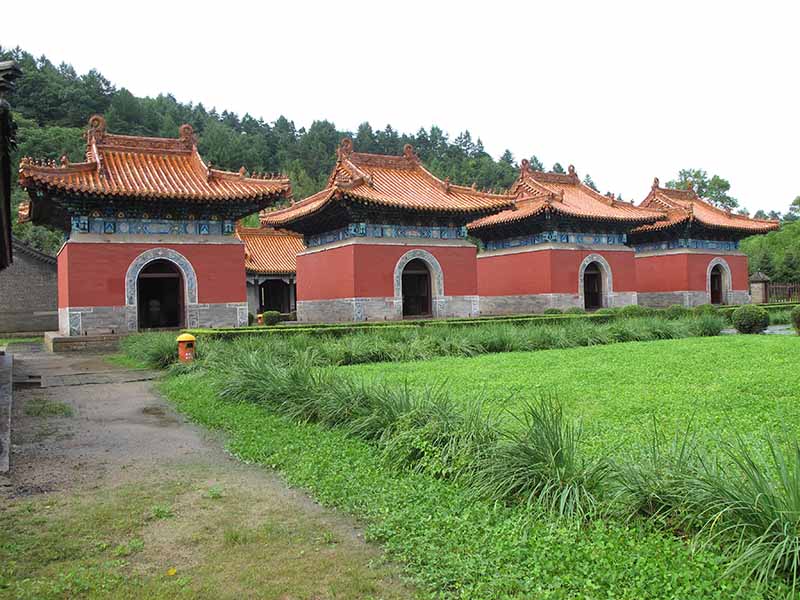
Yongling Tomb, built in 1536, is the tomb for Emperor Shizong, Zhu Houcong (1507-1566). He ruled for 45 years.
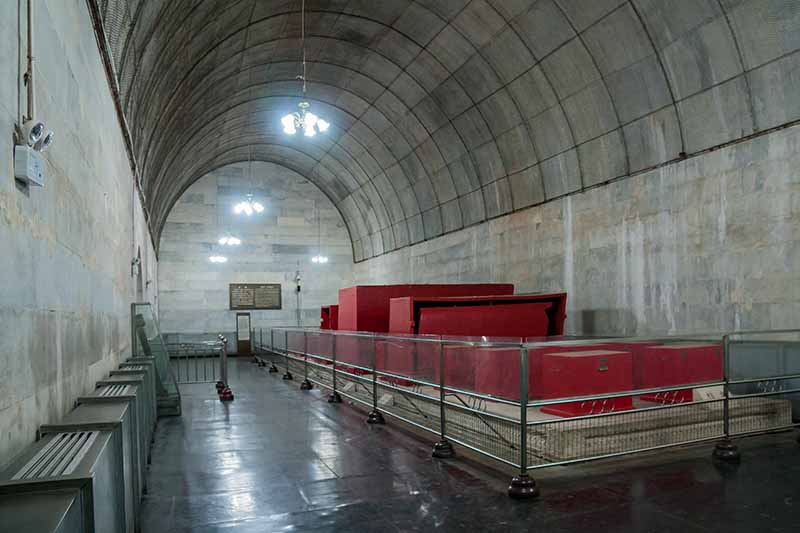
The Dingling Tomb is the tomb of Emperor Wanli (reigned 1573-1619), the 13th emperor of the Ming Dynasty, whose personal name was Zhu Yijun, and of his two empresses, Xiao Duan and Xiao Jing. The tomb was completed in six years (1584-1590), it occupies a total area of 1,195 square meters at the foot of Dayu Mountain southwest of the Changling Tomb.
The underground palace at Dingling Tomb consists of an antechamber, a central chamber and a rear chamber plus the left and right annexes. One of the pictures shows the central chamber where the sacrificial utensils are on display. Two marble doors are made of single slabs and carved with life-size human figures, flowers and birds. More than 3,000 articles have been unearthed from the tumulus, the most precious being the golden crowns of the emperor and his queen.
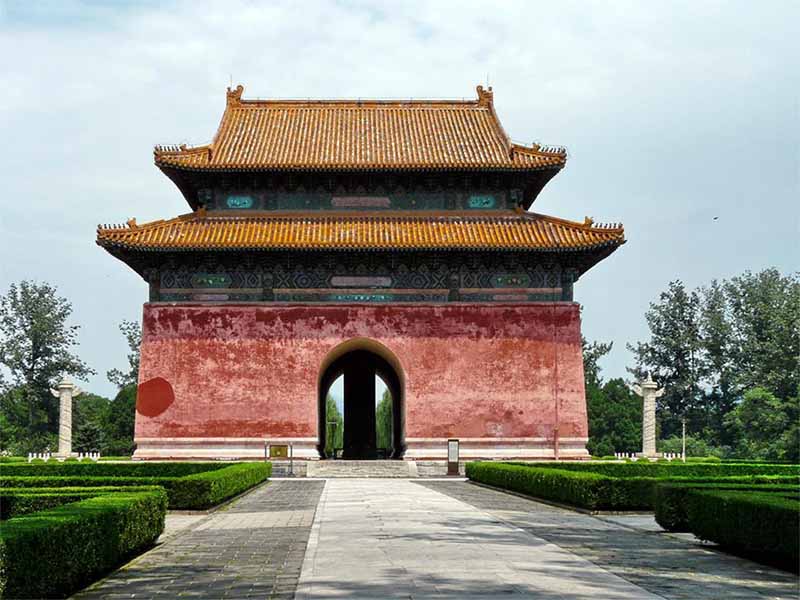
Changling is the tomb of emperor Yongle (reigned 1403-1424), the third emperor of the Ming Dynasty whose personal name was Zhu Di, and of his empress. Built in 1413, the mausoleum extends over an area of 100,000 square metres. The soul tower, which tells people whose tomb it is, rests on a circular wall called the "city of treasures" which surrounds the burial mound. The "city of treasures" at Changling has a length of more than a kilometer.
Funerary art varied greatly across Chinese history: tombs of early rulers rival the ancient Egyptians for complexity, and the value of the grave goods, and have been equally pillaged over the centuries by tomb robbers.
For a long time literary references to Jade burial suits were regarded by scholars as fanciful myths, but a number of examples were excavated in the 20th century, and it is now believed that they were relatively common among early rulers.
Knowledge of pre-dynastic Chinese culture has been expanded by spectacular discoveries at Sanxingdui and other sites. Very large tumuli could be erected, and later mausoleums. Several special large shapes of Shang dynasty bronze ritual vessels may have been made for burial only; the Tomb of Fu Hao is one of the few undisturbed royal tombs of the period to have been excavated - most funerary art has appeared on the art market without archaeological context.
The Complex of Goguryeo Tombs, from a kingdom of the 5th to 7th centuries, which included modern Korea, are especially rich in paintings.
Only one of the Imperial Tombs of the Ming and Qing Dynasties has been excavated, in 1956, with such disastrous results for the conservation of the thousands of objects found, that the current policy is to leave them undisturbed.
The Lei Cheng Uk Han Tomb Museum in Hong Kong displays a far humbler middle-class Han dynasty tomb.
Sculptures of guardian figures, whether the terracotta army or later Buddhist deity figures, are common. Early burial customs show a strong belief in an afterlife, and a spirit path to it that needed facilitating. Funerals and memorials were also an opportunity to reaffirm important cultural values such as filial piety and "the honor and respect due to seniors, the duties incumbent on juniors".
The common Chinese funerary symbol of a woman in the door may represent a "basic male fantasy of an elysian afterlife with no restrictions: in all the doorways of the houses stand available women looking for newcomers to welcome into their chambers" Han Dynasty inscriptions often describe the filial mourning for their subjects.
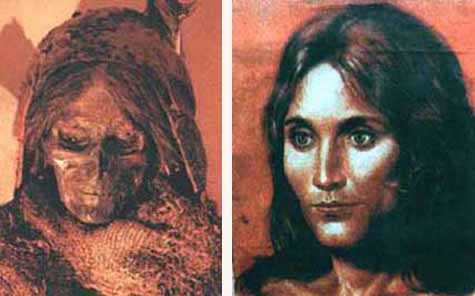
Tarim Mummies

Pyramids of Tibet
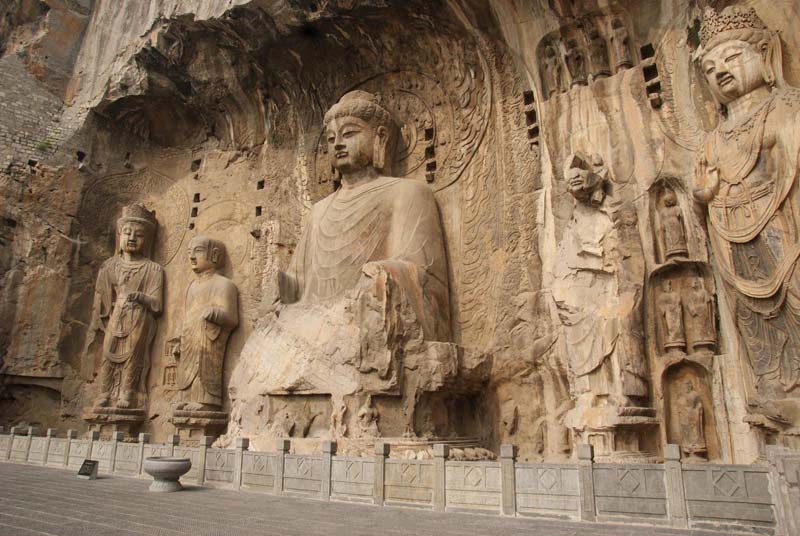
Dunhuang Caves - Art and Manuscripts
Women likely ruled in Stone Age China, DNA analysis of 4,500-year-old skeletons reveals Live Science - June 23, 2025

Genetic analysis of 60 people buried in a Stone Age cemetery has revealed two clans headed by women that spanned 10 generations.